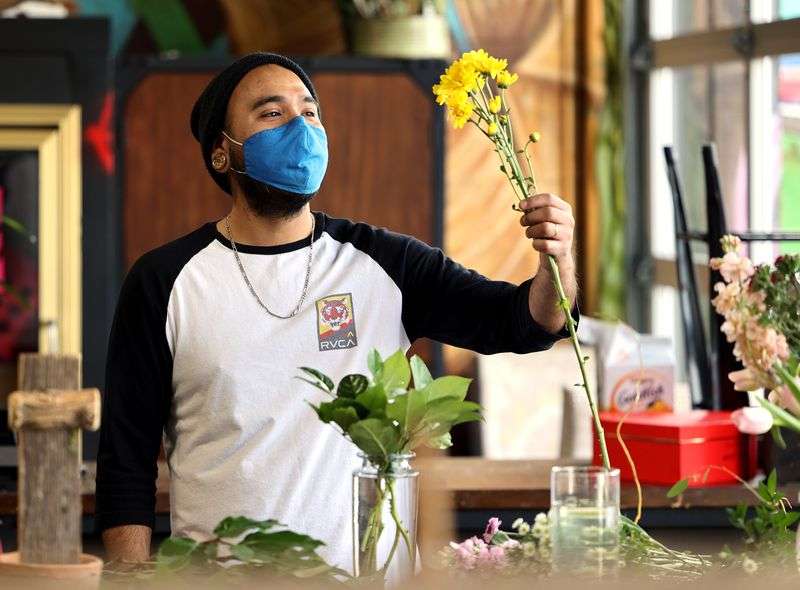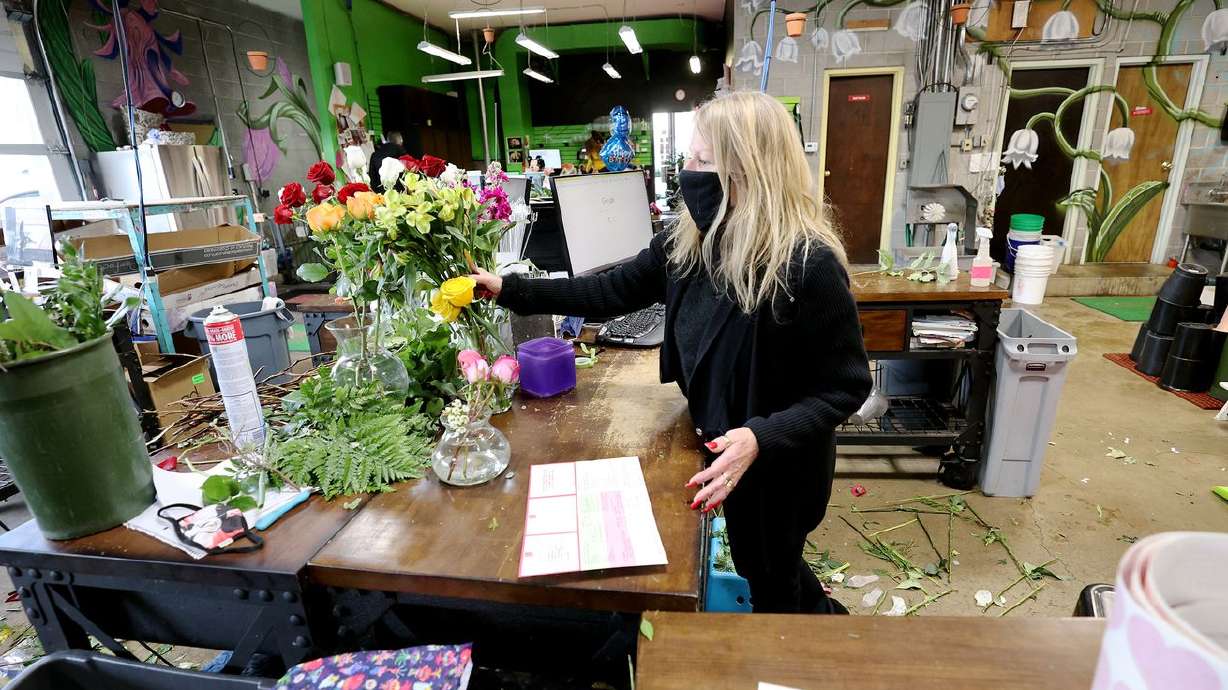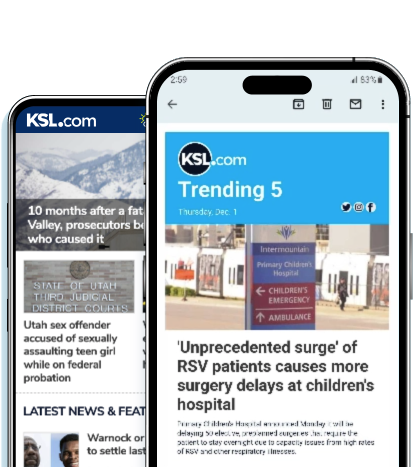Estimated read time: 6-7 minutes
This archived news story is available only for your personal, non-commercial use. Information in the story may be outdated or superseded by additional information. Reading or replaying the story in its archived form does not constitute a republication of the story.
SALT LAKE CITY — Last year, when the COVID-19 outbreak initially struck, Marci Rasmussen's downtown floral shop was one those businesses that felt the direct impact.
"I immediately laid everybody off," she said. That meant all but one of her 15 employees.
Surviving the coronavirus pandemic as a small business has been particularly challenging. For those that were able to make it, that survival didn't come without a lot of angst and at least a bit of help.
For longtime Salt Lake business owner Rasmussen and others, that good luck came in the form of the Paycheck Protection Program that was part of the federal government pandemic relief package last year. Now, many of those same business owners are hoping to access a few more of those federal dollars approved in another aid bill passed in December to keep their enterprises going a little while longer as the COVID-19 outbreak continues to wreak financial havoc throughout the state and the country.
Starting this week, small businesses hit hard by the pandemic have been able to apply or reapply for the Paycheck Protection Program — a forgivable loan program established by the 2020 Coronavirus Aid, Relief and Economic Security Act.
Rasmussen said she will be among those seeking another infusion of federal help.

"When (the government) first decided to shut down, my business fell off the cliff. (All my) corporate accounts except one — there were 43 of them — restaurants and hotels that do flowers every week," Rasmussen said. "I lost 13 weddings. We had probably nine conventions set up and those slowly canceled throughout the year."
Fortunately, the layoffs weren't permanent.
"We came in as an essential business because we do funeral flowers, so me and my daughter-in-law ran it until I got the PPP and the minute I got (the money) I brought everybody back," she said.
Since then, she has seen her business slowly recover though not to pre-pandemic levels. She estimated that she's lost 20% of her revenue over the past year and is just making enough to get by at this point.
"I'm paying my bills and paying my employees but I'm not making any money," Rasmussen said. "My profits are not staying the same. (But) I'm truly blessed because I've been around long enough that I've made it through three different recessions.
"I started in a recession. I always have backup," she said. "I keep money in the business. If my business has money in it, I don't take the money (in profits) I leave it there."
She plans to apply for the same $70,000 amount she received during the first round of funding, believing it should be enough to sustain the business until vaccines allow life to become more normalized.
Meanwhile, local lenders are preparing for the new wave of of applicants when the new round of PPP funding becomes available. One difference expected for this round is a focus on involving community development financial institutions that serve small businesses rather than larger lenders that serve big companies and corporate clients, which is what drew criticism the first time around.
"Only the (community development financial institutions) are able to (accept applications) right now ... they were able to open up their portals and they were able to start accepting applications for first draws. (This week) they'll be able to open up for second draws," said Tom Morgan, executive vice president of retail banking at Zions Bank. The smaller local lenders can take first-time applicants and those like Rasmussen who will be applying a second time, having received money during the initial CARES Act funding.

The program will soon open to all other lenders at a date to be announced by the Small Business Administration, he said.
This time around, loans will be capped at $2 million, as opposed to $10 million previously. However, loans will cover additional expenses not previously allowed by PPP, such as for operations, property damage, supplier and worker protection expenditures.
The program's eligibility is also expanding to include 501(c)(6) nonprofits, housing cooperatives and destination marketing organizations, among other types of entities.
"What this is doing is really spotlighting the idea that the SBA and the federal government really want to get the money to these small organizations, these smaller companies," Morgan said. "They've even specifically set aside money for institutions that are very small — 10 employees or less — and in doing that, opening up to the small institutions first. That's really targeting to get that money right to where they want it to go first."
"It's targeting the small small businesses. These are the ones that are at most risk. Since the spring of last year, these are the kinds of businesses that have gone out of business," he said. "What (the SBA) wants is for those businesses that are still there is to get the lifesaving funds to those guys first."
The new PPP provides greater flexibility for seasonal employees, according to Ryan Shaw, Zions Bank's director of business banking. For first-time loan applicants, businesses with up to 500 employees are eligible, he added.
Some businesses and self-employed individuals can apply for a second PPP loan. However, to qualify, these businesses must have fewer than 300 employees and show a 25% loss for at least one quarter in 2020.

He said applicants will need documents to verify payroll costs and revenue loss, such as tax forms or bank statements.
Additionally, administrators have implemented new rules that will increase the time it will take to receive funds due to more stringent policies to prevent fraud.
"They have changed the way in which we'll submit and apply and receive our authorizations," Shaw said. "We don't know exactly the time frame, but we know that it will take a little longer to get the authorizations from the SBA this time, and hence the funding might be a little slower than it was."
Shaw noted that last time, some businesses received funding within 24 hours, but this round the timing will likely be just a few days rather than an extended period.
"By doing that they've also expanded the uses of funds that are eligible for this round. While 60% of the funds still needs to be used for payroll in order to receive the full forgiveness, they've expanded the other uses," he said. "(It includes) rent mortgage interest, you can now pay for supplies and materials that your company purchases. You can buy (personal protective equipment) for your employees."
"You can also pay for any damage to physical property that might have been caused by riots or unrest that might have happened in your area," Shaw said. "The main goal obviously is to still have employees actively employed and paid, but they also realize there were other expenses that were being incurred by businesses."









